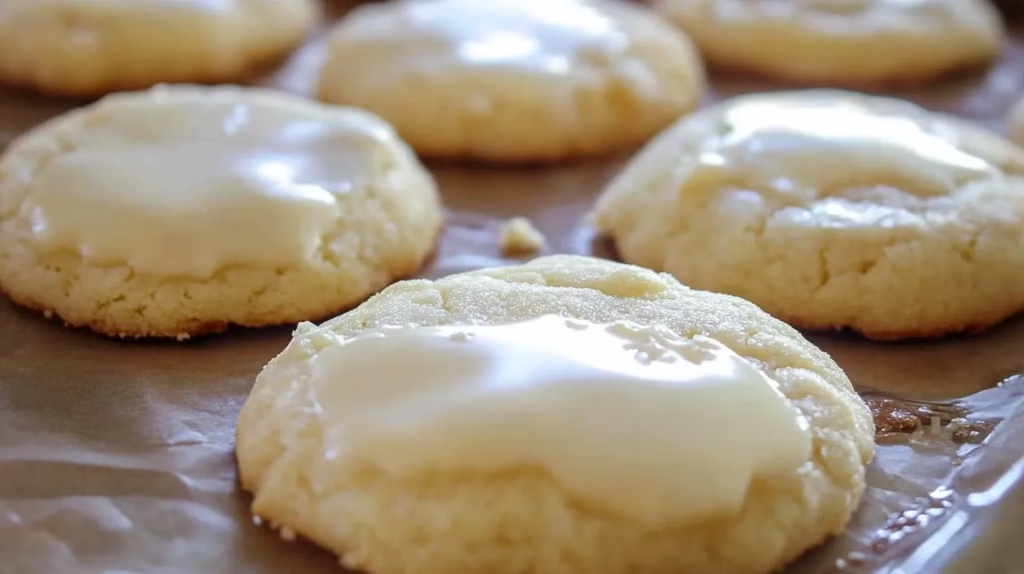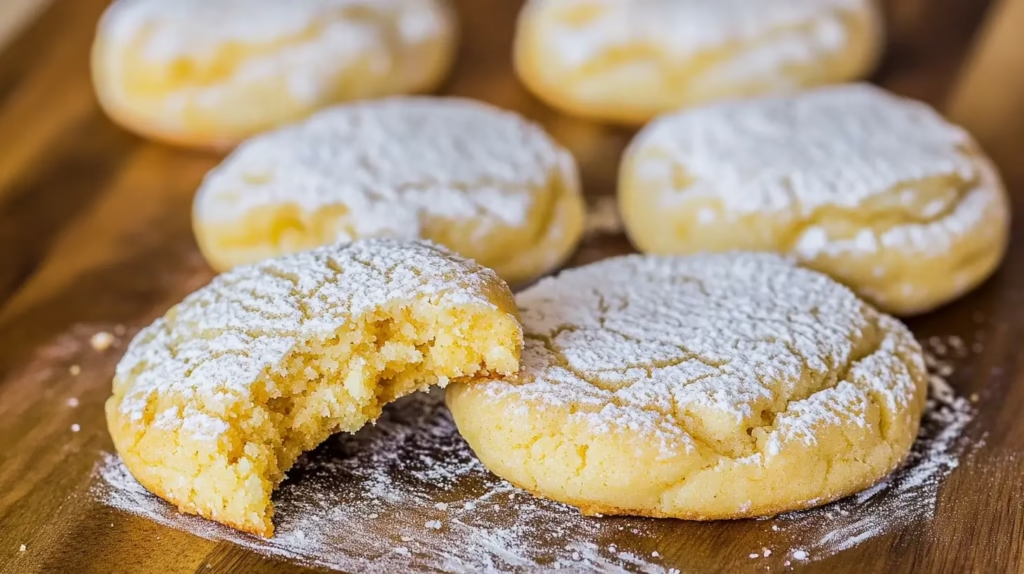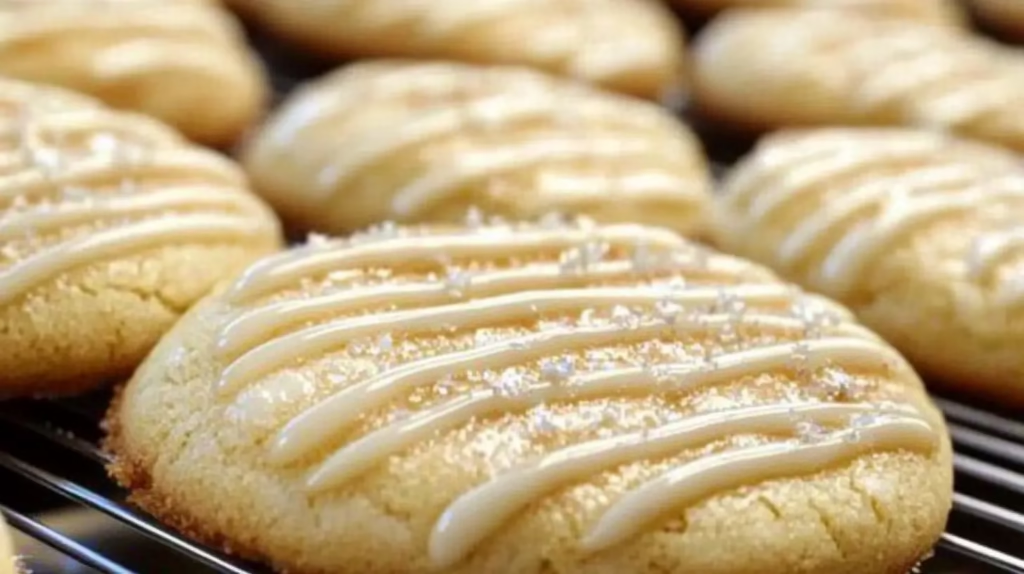What Are Kentucky Butter Cake Cookies?
Kentucky Butter Cake Cookies are a delightful twist on the classic Kentucky Butter Cake, transforming the rich, buttery flavor of the original dessert into a compact and convenient cookie form. These cookies are characterized by their soft, melt-in-your-mouth texture, with a buttery glaze that creates a slightly crisp, caramelized exterior. Perfect for tea time, holiday gatherings, or as a standalone dessert, they bring a unique mix of sweetness and indulgence to your plate.

Origins of Kentucky Butter Cake
The origins of Kentucky Butter Cake trace back to the Southern United States, where home bakers perfected the art of simple yet flavorful desserts. The cake itself became famous for its moist crumb and luscious glaze made from butter, sugar, and vanilla. When bakers started adapting the recipe for cookies, they preserved these key characteristics, offering a bite-sized option that’s easier to serve.
How the Cookies Are Inspired by the Cake
The cookies maintain the buttery richness and dense texture of the original cake. A drizzle of glaze often mimics the signature topping, ensuring the same flavor profile but with added portability. The result is a dessert that’s both comforting and versatile, combining nostalgia with practicality.
Unique Features of Kentucky Butter Cake Cookies
What sets these cookies apart is their ability to capture the essence of a traditional cake while offering modern convenience. Unlike other cookies, they rely heavily on butter and a specific mixing technique to achieve their characteristic richness. The addition of a glaze after baking is not commonly seen in cookie recipes, making these a standout treat.
Ingredients for Kentucky Butter Cake Cookies
Key Ingredients for the Cookies
The ingredients for Kentucky Butter Cake Cookies are simple yet crucial for achieving their signature taste and texture. Here’s what you’ll typically need:
- Butter: The star ingredient. Unsalted butter is preferred for better control of salt content in the recipe. It provides the rich, creamy base that gives these cookies their melt-in-your-mouth quality.
- Sugar: A combination of granulated sugar and powdered sugar is often used. Granulated sugar helps with structure and sweetness, while powdered sugar contributes to the soft texture.
- Flour: All-purpose flour is the standard choice, providing the necessary structure without making the cookies too dense.
- Eggs: Eggs act as a binder and add moisture, helping the cookies stay tender.
- Vanilla Extract: This enhances the flavor profile, adding warmth and depth to the buttery base.
- Baking Powder or Baking Soda: A leavening agent is used to give the cookies just a touch of lift, preventing them from being overly dense.
- Salt: A pinch of salt balances the sweetness and brings out the buttery notes.
These core ingredients come together to create the base of the cookie. However, the glaze is where the magic happens.
The Role of Butter and Flavor Enhancers
Butter is not only the foundation of the cookie dough but also a critical component of the glaze. The glaze typically consists of melted butter, powdered sugar, vanilla extract, and sometimes a splash of cream or milk for consistency. When poured over the warm cookies, it soaks in slightly, forming a caramelized crust as it cools. This dual use of butter amplifies the richness and ensures the cookies live up to their “butter cake” name.
To enhance the flavor further, some recipes include optional ingredients such as almond extract, nutmeg, or even a hint of bourbon. These additions add complexity and make the cookies even more unique.
Substitutions for Dietary Restrictions
If you’re baking for individuals with dietary restrictions, you can make a few adjustments:
- Dairy-Free Options: Substitute butter with vegan butter or coconut oil. Use almond milk or soy milk for the glaze.
- Gluten-Free Flour: Swap regular flour with a gluten-free baking blend that includes xanthan gum for structure.
- Sugar Substitutes: For a lower-sugar version, use a granulated sugar substitute like erythritol or monk fruit sweetener.
- Egg Replacements: Flaxseed meal mixed with water or a commercial egg replacer can be used to make these cookies egg-free.
These substitutions allow more people to enjoy this decadent treat without compromising on flavor.
Step-by-Step Guide to Making Kentucky Butter Cake Cookies
Making Kentucky Butter Cake Cookies is a straightforward process that involves a few key steps. Each stage is designed to ensure the cookies achieve their rich flavor and perfect texture. Let’s walk through the process.
Preparing the Ingredients
Before you begin, it’s essential to gather and prepare your ingredients.
- Room Temperature Butter and Eggs: Allow the butter and eggs to come to room temperature. This ensures the butter creams smoothly with the sugar, creating an airy and well-mixed dough.
- Measure Accurately: Use measuring cups and spoons to measure your dry and wet ingredients precisely. Baking is a science, and small inaccuracies can affect the final outcome.
- Preheat the Oven: Set your oven to 350°F (175°C) and line your baking sheets with parchment paper or silicone mats for even baking.
Mixing the Dough
The mixing process is crucial for achieving the right consistency.
- Creaming Butter and Sugar: Use a hand mixer or stand mixer to cream the butter and sugar together until the mixture is light and fluffy. This step incorporates air into the dough, ensuring the cookies have a tender texture.
- Adding Wet Ingredients: Gradually add the eggs and vanilla extract, mixing until fully combined. Be careful not to overmix, as this can make the cookies dense.
- Incorporating Dry Ingredients: Sift together the flour, baking powder or soda, and salt in a separate bowl. Slowly add the dry mixture to the wet ingredients, mixing just until combined.
At this point, the dough should be soft but not sticky, and it’s ready to be shaped.
Shaping and Baking Tips
- Portioning the Dough: Use a cookie scoop or tablespoon to portion out even-sized balls of dough. This ensures consistent baking.
- Spacing: Place the dough balls on the prepared baking sheet, leaving at least 2 inches between each to allow for spreading.
- Baking: Bake in the preheated oven for 10–12 minutes, or until the edges are lightly golden. The centers may still look slightly underbaked, but they will set as the cookies cool.
Making the Butter Glaze
The butter glaze is what elevates these cookies from good to unforgettable.
- Ingredients: Combine melted butter, powdered sugar, vanilla extract, and a splash of cream or milk in a bowl. Whisk until smooth.
- Consistency: The glaze should be pourable but thick enough to coat the back of a spoon. Adjust with more cream or powdered sugar as needed.
Glazing the Cookies for Best Results
Once the cookies come out of the oven, allow them to cool for 5–10 minutes. While they’re still slightly warm:
- Drizzle or brush the glaze over each cookie generously.
- Let the glaze set for a few minutes, creating a slightly crispy layer on the outside.
This step locks in moisture and enhances the buttery flavor, making every bite irresistible.
Essential Equipment for Baking Kentucky Butter Cake Cookies
To achieve the best results when baking Kentucky Butter Cake Cookies, it’s important to use the right tools. While the recipe is simple, having the proper equipment ensures your cookies turn out with the perfect texture and presentation.
Recommended Mixing Tools
- Stand Mixer or Hand Mixer: A stand mixer with a paddle attachment is ideal for creaming butter and sugar. It saves time and ensures a well-incorporated dough. If you don’t have a stand mixer, a hand mixer works just as well.
- Mixing Bowls: Use sturdy, non-slip bowls in varying sizes to mix your wet and dry ingredients. Stainless steel or glass bowls are great choices.
- Rubber Spatula: A spatula is useful for scraping down the sides of the bowl to ensure all ingredients are evenly combined.
These tools are essential for creating a smooth dough and evenly incorporating all the flavors.
Baking Sheets and Liners
- Baking Sheets: Invest in high-quality, heavy-duty baking sheets that distribute heat evenly. Thin or low-quality sheets can lead to uneven baking or burnt cookie bottoms.
- Parchment Paper or Silicone Mats: Line your baking sheets with parchment paper or reusable silicone baking mats. These prevent sticking, reduce the need for extra grease, and promote even browning on the bottom of the cookies.
Lining your baking sheets also makes cleanup much easier, saving you time in the kitchen.
Storage Containers for Freshness
After baking your cookies, storing them properly is key to maintaining their flavor and texture.
- Airtight Containers: Use airtight containers to keep your cookies fresh for up to a week. Ensure the cookies are completely cooled before storing to prevent condensation and sogginess.
- Cookie Tins: Metal cookie tins are another excellent option, especially for gifting. They provide a charming presentation and keep the cookies fresh.
- Wax or Parchment Paper: If stacking the cookies in a container, place wax or parchment paper between layers to prevent sticking.
Proper storage not only keeps your cookies tasting their best but also extends their shelf life, allowing you to enjoy them over several days.
Variations and Creative Twists
Kentucky Butter Cake Cookies are delicious as they are, but adding a few creative twists can make them even more exciting. By incorporating additional flavors, textures, and dietary options, you can customize the cookies to suit any occasion or preference.

Flavored Kentucky Butter Cake Cookies
- Lemon or Citrus Flavor: Add a tablespoon of lemon or orange zest to the dough for a bright, tangy twist. You can also replace vanilla extract in the glaze with lemon juice for a refreshing flavor.
- Cinnamon and Nutmeg: For a warm and cozy flavor, add a teaspoon of cinnamon and a pinch of nutmeg to the dry ingredients. This variation is perfect for fall or holiday baking.
- Almond or Coconut Extract: Swap or combine vanilla extract with almond or coconut extract to introduce a subtle, nutty undertone.
These simple changes can elevate the cookies while still maintaining their rich and buttery essence.
Adding Nuts, Chocolate, or Fruits
- Chopped Nuts: Fold in ½ cup of chopped pecans, walnuts, or almonds to add a delightful crunch to the cookies.
- Chocolate Chips: Incorporate white chocolate chips, milk chocolate chunks, or dark chocolate bits for a decadent touch.
- Dried Fruits: Mix in dried cranberries, raisins, or diced apricots for a sweet and chewy contrast to the buttery base.
These additions not only enhance the texture but also introduce exciting flavor combinations that appeal to a broader audience.
Gluten-Free and Vegan Adaptations
For those with dietary restrictions, adapting the recipe can make these cookies accessible without compromising on taste or texture.
- Gluten-Free: Replace regular flour with a high-quality gluten-free baking blend. Ensure the blend includes xanthan gum or another binder for proper structure.
- Vegan: Use vegan butter and replace eggs with a flaxseed or chia seed mixture (1 tablespoon of flaxseed meal or chia seeds mixed with 3 tablespoons of water per egg). For the glaze, opt for almond milk or coconut milk instead of cream.
These adaptations allow everyone to enjoy the cookies, regardless of dietary preferences or allergies.
Troubleshooting Common Issues
Even with a straightforward recipe like Kentucky Butter Cake Cookies, challenges can arise. Knowing how to troubleshoot common issues ensures that your cookies come out perfectly every time. Here are some tips to address potential problems:
Why Cookies Might Turn Out Dry
Dry cookies are often the result of improper measurements or baking techniques. Here’s how to avoid this issue:
- Accurate Measurements: Use measuring cups for dry ingredients and a kitchen scale for precise accuracy. Too much flour can lead to a dry and crumbly texture. Always level off the flour with a knife rather than scooping it directly from the bag.
- Overbaking: Check your cookies a minute or two before the suggested baking time. Overbaking causes the moisture to evaporate, leaving you with dry cookies. The cookies should look slightly underbaked in the center when you remove them from the oven.
- Butter Temperature: Ensure your butter is at room temperature before creaming. If it’s too cold, it won’t incorporate properly with the sugar, leading to a drier dough.
How to Avoid Overbaking
Overbaking is one of the most common mistakes when making cookies. Follow these tips to get the timing just right:
- Preheat the Oven: Always preheat your oven fully before baking to ensure the cookies bake evenly.
- Use an Oven Thermometer: Oven temperatures can vary, so using a thermometer ensures your cookies bake at the correct heat.
- Watch for Visual Cues: Look for lightly golden edges and a soft, slightly puffy center. The cookies will continue to bake on the baking sheet after being removed from the oven, so don’t wait for them to look fully set.
Tips for Achieving the Perfect Glaze
The butter glaze is a defining feature of Kentucky Butter Cake Cookies. To ensure the glaze enhances rather than detracts from the cookies:
- Consistent Thickness: The glaze should be thin enough to drizzle but thick enough to coat. If it’s too runny, add more powdered sugar; if it’s too thick, thin it out with a splash of milk or cream.
- Glazing While Warm: Always apply the glaze while the cookies are still slightly warm. This helps it soak into the cookie surface, creating a moist and flavorful finish.
- Avoid Overdoing It: While the glaze is delicious, too much can make the cookies overly sweet. Drizzle just enough to form a thin, shiny layer.
By addressing these common issues and following the tips, you can achieve bakery-quality Kentucky Butter Cake Cookies every time.
How to Store and Serve Kentucky Butter Cake Cookies
Storing and serving Kentucky Butter Cake Cookies correctly is key to preserving their delightful texture and flavor. Whether you’re preparing them for a family treat or a special occasion, these tips will ensure your cookies remain fresh and appealing.

Storing for Short-Term and Long-Term Freshness
Proper storage techniques can make a significant difference in how long your cookies stay delicious.
- Short-Term Storage:
- Store cookies in an airtight container at room temperature for up to a week.
- Separate layers with parchment or wax paper to prevent sticking and preserve their glaze.
- Avoid storing in direct sunlight or near heat sources, as this can affect the glaze’s texture.
- Freezing for Long-Term Storage:
- Unbaked Dough: Portion the dough into cookie-sized balls, place them on a baking sheet, and freeze until firm. Transfer the frozen dough balls to a freezer-safe bag and store for up to three months. Bake directly from frozen, adding 1–2 minutes to the baking time.
- Baked Cookies: Let cookies cool completely, then freeze them in a single layer on a baking sheet. Once frozen, transfer to an airtight container or freezer-safe bag. Defrost at room temperature when ready to serve.
Proper storage ensures that the cookies retain their buttery richness and soft texture, whether you’re enjoying them immediately or saving them for later.
Best Ways to Serve and Pair the Cookies
Kentucky Butter Cake Cookies are versatile and pair beautifully with various beverages and accompaniments.
- Tea and Coffee: Serve these cookies alongside a cup of tea, coffee, or a latte for a cozy and indulgent treat. The buttery sweetness complements the warmth and bitterness of these drinks.
- Milk: A classic glass of cold milk pairs perfectly with these cookies, balancing their richness.
- Dessert Platter: Add Kentucky Butter Cake Cookies to a dessert platter featuring fruits, chocolates, and other baked goods. Their distinct glaze and buttery flavor make them a standout option.
- Ice Cream Sandwiches: For a creative twist, sandwich a scoop of vanilla or caramel ice cream between two cookies. This adds a creamy, refreshing element to the dessert.
Gifting Ideas with Kentucky Butter Cake Cookies
These cookies also make wonderful gifts, thanks to their unique flavor and beautiful presentation.
- Decorative Tins: Pack the cookies in decorative tins or festive boxes lined with parchment paper. Add a personalized note or ribbon for an extra special touch.
- Holiday Themes: Use colored glaze or sprinkles to match holiday themes. For example, red and green sprinkles for Christmas or pastel glaze for Easter.
- Cookie Bouquets: Arrange the cookies on sticks to create a cookie bouquet. This creative presentation is perfect for birthdays, weddings, or baby showers.
By storing and serving your cookies thoughtfully, you can elevate the experience and make them memorable for any occasion.
FAQs About Kentucky Butter Cake Cookies
To address common questions about Kentucky Butter Cake Cookies, here are detailed answers that clarify what makes these cookies unique and how they can be enjoyed or customized.
What is Kentucky Butter Cake Crumbl?
Kentucky Butter Cake Crumbl refers to a specific adaptation of Kentucky Butter Cake Cookies, popularized by Crumbl Cookies, a renowned bakery chain. Their version of this treat features a soft, buttery cookie base topped with a rich glaze or frosting that mimics the original cake’s signature glaze. Often, it is finished with decorative swirls or a sprinkling of sugar for added texture. Crumbl’s take on the cookies highlights their indulgent and over-the-top flavor, making them a favorite among dessert enthusiasts.
What is Kentucky Butter Cake Made Of?
Kentucky Butter Cake, the inspiration for the cookies, is a dense and moist pound cake made with basic pantry staples like butter, sugar, eggs, flour, and vanilla. The key feature is the buttery glaze, poured over the cake while it’s still warm, soaking into the crumb and creating a caramelized layer on the outside. The cookies capture these elements by incorporating a buttery dough and replicating the glaze as a topping, ensuring every bite has the same richness and sweetness.
What’s the Difference Between Sugar Cookies and Butter Cookies?
While both sugar cookies and butter cookies are beloved classics, their textures and flavors differ significantly:
- Butter Content:
- Butter Cookies: These rely heavily on butter for their flavor and texture. They are richer and softer, with a melt-in-your-mouth quality.
- Sugar Cookies: Though they also contain butter, the focus is more on sugar. They are firmer and often used for decorating.
- Texture:
- Butter Cookies: Have a delicate, tender texture due to the high fat content.
- Sugar Cookies: Are slightly crisp on the edges and hold their shape better, making them ideal for cookie cutters.
Kentucky Butter Cake Cookies fall firmly into the butter cookie category due to their rich flavor and tender texture, enhanced by the glaze that sets them apart.
Is It Better to Use Butter or Oil in Cake Mix Cookies?
When making cookies, particularly Kentucky Butter Cake Cookies, butter is the better choice. Here’s why:
- Flavor: Butter adds a rich, creamy flavor that oil cannot replicate. This is especially important for cookies inspired by butter cake, as the buttery taste is essential to the recipe.
- Texture: Butter provides structure and creates a tender, melt-in-your-mouth texture. Oil, while adding moisture, can make cookies too soft or greasy.
- Glaze Compatibility: Butter also plays a crucial role in the glaze, enhancing the overall flavor and texture of the cookies.
While oil might work in other types of cookies for moisture, butter is a non-negotiable ingredient for achieving the authentic taste and texture of Kentucky Butter Cake Cookies.
Conclusion
Kentucky Butter Cake Cookies are a delightful blend of tradition and innovation, capturing the essence of a classic Southern dessert in a portable, bite-sized form. These cookies stand out for their rich, buttery flavor, tender texture, and signature glaze that adds a caramelized sweetness. Whether enjoyed as a simple treat or customized with creative twists, they bring indulgence and comfort to any occasion.
From their origins in the classic Kentucky Butter Cake to their evolution as cookies, these treats have maintained their status as a crowd-pleaser. With a straightforward recipe and versatile adaptations, they cater to a wide range of tastes and dietary preferences. The ability to store them for days or freeze them for longer ensures they’re always on hand for moments of indulgence.
Whether you’re baking them for a family gathering, gifting them in decorative tins, or simply treating yourself, Kentucky Butter Cake Cookies offer a unique and satisfying experience. Their versatility in flavors, ease of preparation, and nostalgic charm make them a standout dessert worth trying.
